| Allegheny
River Islands Wilderness Expedition: Warren, Buckaloons, Thompson
Island |
Dale
Luthringer |
| Sep
12, 2007 15:32 PDT |
ENTS,
Ed Frank, Tony Kelly, and I spent Labor Day Weekend on a tree
measuring
expedition down the Allegheny River via canoe to document tall
and
noteworthy trees within the Allegheny River Islands Wilderness
Area. It
was an incredible 4 day trip down what the French called, La
Belle
Riviere, and what a magnificently beautiful river it is. It had
been
probably 10 years since I last canoed the stretch we were going
to be
on, and the first time I had been on it since I caught the old
growth
forest/big tree bug back in 1997.
The U.S. Forest Service supplied a brief explanation of the
islands we
were about to explore:
--------------------------------------
http://www.fs.fed.us/r9/forests/allegheny/recreation/wilderness/allegheny_islands/
“Seven islands in the Allegheny River, totaling 368 acres, are
part of
the Allegheny Islands Wilderness. All are alluvial in origin,
which
means they were formed by water-carried deposits of sand, mud
and clay.
They are characterized by river bottom forest trees such as
willow,
sycamore and silver maple. The islands are located between
Buckaloons
Recreation Area and Tionesta, PA. They are:
Ed and I met Sunday evening, 9/2/07, at the Buckaloons
Recreation Area
where we set up our base of operations. After we set up
camp, we took
off to inspect Will Blozan’s old moss cypress (Chamaecyparis
pisifera `
Squarrosa' record along
Irvine Run,
after we were told by the camp hosts
that it was no longer
standing. Well, it’s still standing. It has grown
to 85.1ft high,
which I believe
is now the tallest on record for Pennsylvania,
if not the NE
U.S.
We then headed upstream to investigate big tree reports in
the nearby
town of Warren, courtesy of Kirk Johnson. The first place we
stopped
was to measure a nice Am. Elm on 5th Avenue & Water
Street, which turned
out to be a respectable 13ft CBH x 91.4ft high. It was in
pretty good
condition. We then measured a decent pin oak that caught our
eye on 4th
Avenue to 12ft CBH x 82.4ft high. We next met Tom Paquette
who
requested his large N. red oak on 2nd Avenue be measured
which topped
out at a nice 16.4ft CBH x 95.4ft high. Tom then pointed us
down the
road a piece to nice European copper beech that went to
15.9ft (waist
measured at 2ft, due to swelling of multi-branched trunk
above 4.5ft) x
83.6ft high x 95.1ft avg spread for 298 AF Points. Not bad
for an
evening’s work. Then it was off to a local watering hole
to stock up on
calories for the next day. We were definitely going to need
it…
9/2/07 Warren
Species CBH Height Comments
American elm 13 91.4
European beech 15.9
(at 2ft) 83.6 95.1ft
avg.
spread
N. red oak 16.4 95.4
Pin oak 12 82.4
We woke up early the next morning and made our way past
Anders Run
Natural Area, down river to Thompson Island. It was so foggy
we
couldn’t see across the river. It was so foggy when we got
down to the
put-in point, that I couldn’t tell whether we even had the
right island
or not. Thankfully, I took GPS readings a couple of years
ago when I
measured some decent sycamore from the road that were on the
island’s
edge.
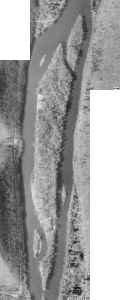
We were across the river in no time and pulled the canoe up
the bank.
It just so happened to be near the base of an Am. basswood,
which was
the largest I had ever personally measured, at 11.3ft CBH x
94.4ft high.
We then started to pick our way through the multiflora rose
barbwire
undergrowth on our way towards the center of the island,
looking for a
new PA sycamore and new NE US hackberry height records. I
had earlier
measured a sycamore to 135.3ft a couple of years earlier,
but had never
been able to set foot on this island. It appeared there were
slightly
taller ones in the center, and we were not disappointed.
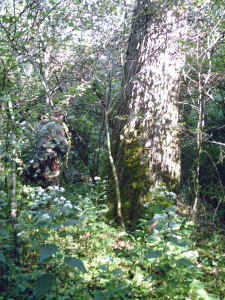 |
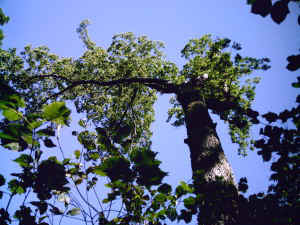
very old Slippery Elm |
We hadn’t gone far when we came upon what appeared to be a
very old
slippery elm with deep furrowed bark, twisted branching, and
heavy lower
trunk moss layer to 11.2ft CBH x 87.1ft high x 35.9ft avg
spread for 231
AF Points. Then, that’s when Ed started getting the eye
for fat & tall
hawthorns... the little-big trees that most of us tend to
breeze past.
Nearby was a fat double branching hawthorn we measured to
5ft CBH on
the largest branch. The skinniest point below the major
branch was
6.1ft at 1.5ft up from the ground. The tree went to a
respectable 5ft
CBH x 34.9ft high x 46.5ft avg spread for 107 AF Points.
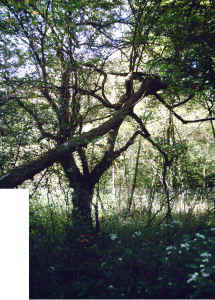
Hawthorn Tree
We reached the center of the island and starting working our
way
up-river and into a nice riverine sycamore forest where we
were quickly
getting into numerous sycamore in the upper 120 to low 130ft
height
class. Ed was first to strike pay dirt when he found a new
state height
record for sycamore at 10.6ft CBH x 140ft high. There were a
number of
other nice sycamore in the area, but we weren’t able to
find another to
top it… on Thompson Island, that is…
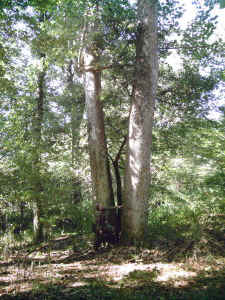 140 ft sycamore is the one on the right.
140 ft sycamore is the one on the right.
We found more hackberry on the island, but weren’t able to
find a new
height record for the species. We then worked our way
downstream on the
island trying to find our way through a 6-8ft wall of
multiflora rose
barbwire fence which then turned into an impenetrable
‘snotweed’ forest.
We ran into a solid wall of Japanese knotweed that ran
virtually the
entire width of the island at about 10-15ft high. I could
hear a quiet
hum that I couldn’t figure out exactly what it was at
first, then it
dawned on me… multitudes of bumble bees were busily
pollinated the
snotweed flowers above us. This section of the island was
dominated by
tall sycamore and silver maple, probably making it into the
130ft and
115ft classes respectively.
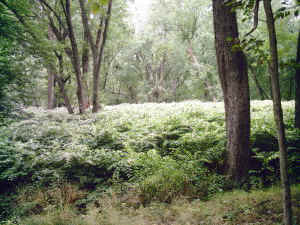
Japanese Knotweed jungle covering the southern
halfof the island
We did our best to break into the snotweed jungle, but were
thwarted at
every attempt. We attempted an ‘end run’ which led us to
a couple of
old high water stream bed channels that cut 6-10ft deep
swaths into the
sediment through the snotweed forest. There were nice N. red
oaks on
the rivers edge, but we couldn’t get far into the interior
of the
snotweed. We did manage to chop a short swath in on the edge
of one of
the old streambed channels, to the base of a very nice
sycamore that
went to 14ft CBH x 122.1ft high… just a taste of what
possibly lay in
the interior.
Ed found a channel that worked our way out the bottom end of
the island,
where we bushwhacked back up-river to the canoe, while
estimating
sycamore & silver maple heights from the rivers edge
into the knotweed
jungle. Most sycamore on the bottom end of the island would
go to the
upper 120ft class, with some going just over 130ft. It is
very possible
there were taller ones in the bottom center of Thompson
Island, but this
will have to wait for a spring trip after the snow and ice
had given a
proper beating to the snotweed.
Then for fun, I decided to canoe AROUND the island to make
sure we
didn’t miss anything on the fringe. Turns out it wasn’t
that much fun
on the upstream paddle. It was a hot day and I only brought
one canteen
of water (Bob, the sorriest man in the outfit is the first
one to
water!). Ed was going through Mountain Dew like it was going
out of
style… I do commend him for the effort. Any lesser man
would’ve
committed mutiny after we had gotten half-way upstream the
backside of
the island. The Allegheny River is no small river. It easily
has 3
times the flow of the Clarion River during its low flow
stages, and we
were paddling up small rapids most of the way. Thompson
Island is one
of the longest islands on the Allegheny River that tops out
at just over
1 mile long and 228 yards at its widest point. This
doesn’t count
another ¼ mile long island just upstream that is part of
Thompson Island
during low flow. A small diagonal side channel, which was
75% dry when
we portaged through it, separates a small island just
upstream from the
main Thompson Island. Needless to say, there were no more
‘1 canteen
days’ for the remainder of the expedition. Two quarts was
the bare
minimum per day.
Common understory trees were small white ash, slippery elm,
bitternut
hickory, and ironwood. Black locust, black walnut, Am.
Basswood, and N.
red oak were dominant on the fringe, but sycamore was
clearly the canopy
dominant species when present. Other species that were
present but not
measured where choke cherry and shagbark hickory. Thompson
Island’s
stats follows:
9/3/07
Thompson Island
Species CBH Height Comments
Am. Basswood 11.3 94.4 personal
largest measure
Am. Basswood 7.8 105.1+
Am. Basswood 9.8 105.1+
Am. Hornbeam 2.5 35.6
Am. Hornbeam 1.2 35.7
Bitternut hickory 5.6 N/A
Bitternut hickory 4.6 96.1+
Bitternut hickory 6.8 104.4
Black cherry 4.3 88.9
Black locust 7.2 90.1+
Black walnut 7.7 107.6
Black walnut 7.7 110.3
Black willow 9.9 84.5
Common hackberry 7.2 81.1+
Common hackberry 7.2 83.3
Hawthorne sp. 4.7 N/A
Hawthorne sp. 3.4(2x)
3 3
Hawthorne sp. 3.1 34.4
Hawthorne sp. 5 34.9 107
AF Points
N. red oak 10.5 N/A
N. red oak 10.4 78.1+
N. red oak 13.1 90.1
N. red oak 13.4 100.4+
12x100 class
N. red oak 13.5 102+ 12x100
class
Pignut hickory
4.3 90.9
Red maple 8.8 86.8
Silver maple 11.3 90.1
Silver maple 11.2 99.1+
Silver maple 20.7(5x)
102.1+
Silver maple 12.7 103.9 12x100
class
Silver maple 24(7x) 108+
Silver maple 10.2 110.5
Slippery elm 11.2 87.1+ “old
growth” tree
Sugar maple
7.8 N/A
Sycamore
14 122.1 beauty,
in knotweed
forest
Sycamore
N/A 127.6
Sycamore
9 132.3+
Sycamore
7.5 134
Sycamore
6.6 134.1
Sycamore
9.1 135.1
Sycamore
7.3 135.5
Sycamore
8.4 136.8+
Sycamore
10.6 140 new
PA height record,
if only for a day…
Vitus sp. 1.4
Vitus sp. 1.6
White ash 8.2 93.1+
White ash 9.3 98.5
White ash 7.3 111.1+
Species present but not measured = choke cherry, shagbark
hickory,
staghorn sumac
Invasives = Japanese knotweed, multiflora rose
Thompson Island Rucker Index = 105.34
Species CBH Height
Sycamore 10.6 140
White ash
7.3 111.1+
Silver maple 10.2 110.5
Black walnut 7.6 110.3
Am. Basswood 9.8 105.1+
Bitternut hickory 6.8 104.4
N. red oak 13.5 102.1+
Pignut hickory 4.3 90.9
Black locust 7.2
90.1+
Black cherry 4.3 88.9
Dale
P.S. future river sections to follow
|
| RE:
Allegheny River Islands Wilderness Expedition: Warren,
Buckaloons, |
Edward
Frank |
| Sep
12, 2007 16:00 PDT |
Dale,
Nice write-up of the trip to Thompson Island. I wanted to
comment that
I was extremely impressed by the hawthorns. They had an
impression of
being very old. Typically these are little bushes, but these
were
simply a few of many that were tree sized with trunks of often
over a
foot in diameter and twenty to thirty feet high and very
gnarled.
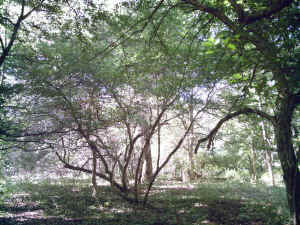
Old-growth forest of hawthorn |
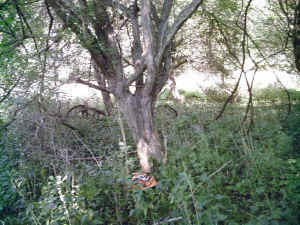
4.7' cbh hawthorn tree on the island |
As for the
Red Oaks. There was another 102+ height 13.0 foot Northern
Red Oak left off the compilation list of trees found on the
island. All
of these were found on the eastern shore of the island.
The largest tree found was a multi-stemmed monster of a silver
maple on
the list. I found it along one of the water channels cutting through
the knotweed forest covering the southern half of the island.
The tree
consisted of a merged mass of perhaps 7 to 9 trunks to a height
of 8 to 9
feet high with a circumference of 24 feet and a height of 108
feet plus
(I could not get a good top shot - this was from underneath).
Very
impressive tree.
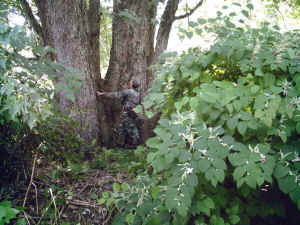
A multi-stemmed Silver Maple among the knotweed jungle
Another tree found was a three stemmed sycamore. Each of the
stems were
mirror images of the other and over 8 feet in circumference.
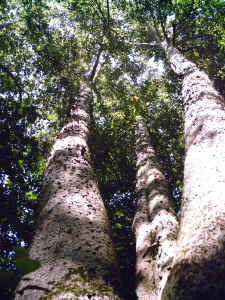
The
tallest was in the upper 120's if I recall correctly. Nice
island.
Ed Frank
|
Re:
Allegeheny River Islands Wilderness Expedition: Warren,
Buckaloons, |
Kirk
Johnson |
|
Sep
12, 2007 21:11 PDT |
Ed and Dale,
Thank you for this interesting report.
For those who might not know, an important reason why those
seven islands in
the Allegheny River are permanently protected is the work of
a
conservationist who happened to grow up in the town of
Tionesta, along the
Allegheny River.
Howard Zahniser led The Wilderness Society from 1945 through
1964, and was
the primary author of the federal Wilderness Act of 1964,
which established
our nation's National Wilderness Preservation System. The
Allegheny Islands
and Hickory Creek Wilderness Areas in the Allegheny National
Forest were
designated in 1984 and are part of that system.
Just opposite the southernmost "No Name"
wilderness island, along State
Route 62 about two miles north of Tionesta, there is a PA
state historical
marker honoring Howard Zahniser:
http://www.phmc.state.pa.us/bah/DOH/markerresults.asp?namesearch=Zahniser
For those who would like to learn more about Zahniser and
his work for
wilderness preservation, there's a bio sketch here:
http://www.pawild.org/zahniser.html
Glad to see you all were able to get up to Warren too to
check out the
residential trees Ed. The elm is taller than I expected, the
red oak maybe a
little shorter than I expected. Both beautiful trees.
Kirk
|
|